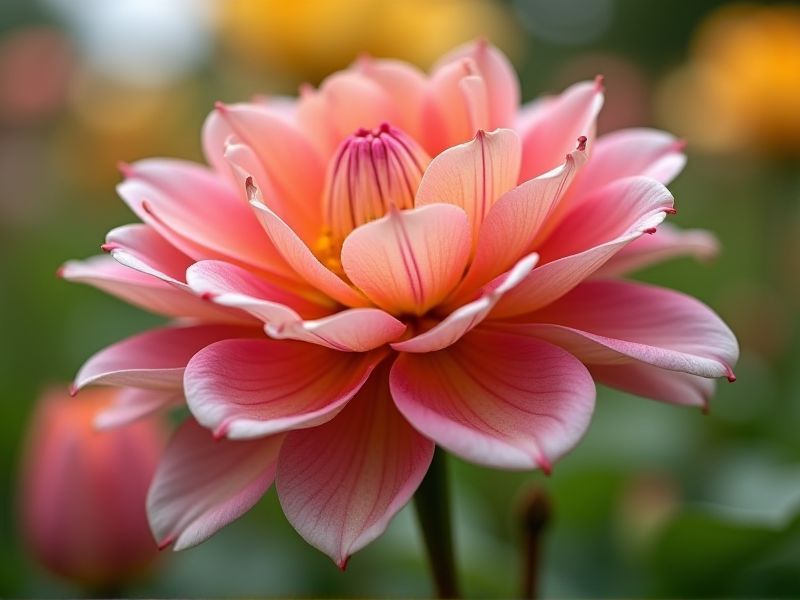
Select perennial flowers such as Daylilies, which provide vibrant blooms from early summer to fall, creating a colorful landscape. Consider incorporating Geraniums, known for their adaptability and long flowering periods, thriving in various climates and adding a splash of color. The resilient Black-eyed Susan offers bright yellow petals and attracts pollinators, ensuring your garden remains lively throughout the season. Include the versatile Sedum, which produces star-shaped flowers in late summer and autumn, complementing other plants with its unique foliage. For a burst of seasonal interest, Petunias are an excellent choice, flourishing in sunny spots and blooming non-stop until frost.
List of some Outdoor plants that bloom all season
- Black-eyed Susan (Rudbeckia hirta)
- Blanket Flower (Gaillardia x grandiflora)
- Daylily (Hemerocallis spp.)
- Geranium (Pelargonium spp.)
- Lantana (Lantana camara)
- Petunia (Petunia spp.)
- Rose (Rosa spp.)
- Salvia (Salvia spp.)
- Verbena (Verbena spp.)
- Zinnia (Zinnia elegans)
Important things about Outdoor plants that bloom all season
Plant Selection
When considering outdoor plants that bloom all season, perennials like Echinacea (Coneflower), Rudbeckia (Black-eyed Susan), and Daylilies are excellent choices that provide continuous color from spring to fall. Xeriscape options such as Lavender and Salvia not only add vibrancy to your garden but also require minimal water, making them perfect for low-maintenance landscapes. Incorporating annuals like Petunias and Marigolds can further enhance your garden's appeal, as they bloom profusely and can fill any gaps left by perennials. Planting a mix of these species ensures a dynamic and ever-changing landscape, offering a delightful visual feast throughout the growing season.
Climate Suitability
Outdoor plants that bloom all season thrive in various climates, providing continuous color and vibrancy to gardens. Options like Petunias, Geraniums, and Salvias are resilient choices known for their extended blooming periods, often attracting pollinators and enhancing biodiversity. Choosing the right soil and ensuring proper sunlight exposure are essential for maximizing the flowering potential of these plants. By incorporating these hardy bloomers, you can create a lively outdoor space that remains visually appealing from spring through fall.
Soil Requirements
Outdoor plants that bloom all season thrive in well-draining soil rich in organic matter, which ensures proper aeration and moisture retention. A pH level between 6.0 and 7.0 is ideal for most flowering perennials, promoting optimal nutrient absorption. Incorporating compost into the soil enhances fertility and encourages beneficial microorganisms, essential for vibrant blooms. Your garden's soil should be regularly mulched to suppress weeds and regulate temperature, further supporting continuous flowering throughout the growing season.
Watering Needs
Outdoor plants that bloom all season typically have specific watering needs to thrive and maintain their vibrant flowers. It's essential to provide consistent moisture, as irregular watering can lead to stress and a reduction in blooms. You should aim to water in the early morning or late afternoon to reduce evaporation and ensure that the roots absorb the moisture effectively. Grouping plants with similar watering requirements can help create a more manageable watering routine for your garden.
Sunlight Exposure
Outdoor plants that bloom all season thrive under ample sunlight, typically requiring at least six hours of direct sunlight daily. Varieties such as marigolds, petunias, and geraniums not only withstand sunlight but also produce vibrant blooms throughout the growing season, creating stunning landscapes. To ensure your garden flourishes, focus on planting in well-drained soil and use appropriate fertilizers to support continuous blooming. Regular deadheading and maintenance will encourage new flowers, maximizing your outdoor space's beauty from spring through fall.
Fertilization Schedule
A consistent fertilization schedule is essential for outdoor plants that bloom all season, ensuring they receive adequate nutrients for optimal growth and vibrant flowers. Applying a balanced, slow-release fertilizer every 6 to 8 weeks during the growing season can significantly enhance blooming potential. You should consider using fertilizers specifically formulated for flowering plants, rich in phosphorus, to promote robust flower development. Monitoring soil health and adjusting your fertilization routine based on plant response can lead to a more flourishing garden with continuous blooms.
Pest Management
Outdoor plants that bloom all season, such as geraniums, petunias, and marigolds, provide continuous color and appeal to any garden. These flowering plants attract pollinators like bees and butterflies, enhancing the ecosystem while enriching your outdoor space. Implementing effective pest management strategies, such as introducing beneficial insects like ladybugs or using organic insecticidal soaps, can protect these vibrant plants from common pests like aphids and caterpillars. Regular inspection for signs of pests and ensuring proper watering and fertilization promote healthy growth, leading to a flourishing garden year-round.
Pruning Techniques
Effective pruning techniques can enhance the health and longevity of outdoor plants that bloom all season, such as geraniums, petunias, and lantanas. Regular deadheading, which involves removing spent flowers, encourages continuous blooms and prevents plants from going to seed, promoting vibrant growth. Heading back stems after the blooming period can rejuvenate the plant, fostering denser foliage and improving air circulation. For optimal results, utilize clean, sharp pruning shears to avoid damaging the plants and to ensure clean cuts that heal quickly.
Companion Planting
Companion planting enhances the growth of outdoor plants that bloom all season, such as marigolds, zinnias, and geraniums. These vibrant flowers not only provide aesthetic appeal, but also attract beneficial insects like pollinators and natural predators that help control pests. For optimal results, consider pairing your blooming plants--such as planting nasturtiums near tomatoes to deter aphids and enhance growth. With careful selection and arrangement, your garden can flourish with color and vitality throughout the entire growing season.
Seasonal Care Adjustments
Outdoor plants that bloom all season, such as petunias, geraniums, and verbena, require careful seasonal care to ensure vibrant displays. Regular deadheading encourages continuous flowering and prevents plants from going to seed. Implementing a consistent watering schedule, particularly during dry spells, helps maintain healthy growth and bloom production. Applying a balanced fertilizer every few weeks supports nutrient needs, promoting lush foliage and abundant blooms throughout the season.
